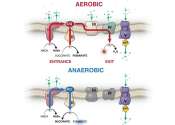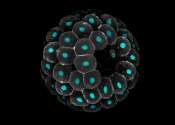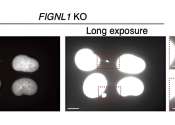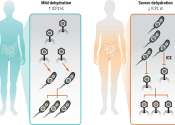Last update:
Cell & Microbiology news

Composition of gut microbiota could influence decision-making
The way we make decisions in a social context can be explained by psychological, social, and political factors. But what if other forces were at work? Hilke Plassmann and her colleagues from the Paris Brain Institute and ...
Cell & Microbiology
8 hours ago
0
34

How heat waves are affecting Arctic phytoplankton
The basis of the marine food web in the Arctic, the phytoplankton, responds to heat waves much differently than to constantly elevated temperatures. This has been found by the first targeted experiments on the topic, which ...
Ecology
May 17, 2024
0
138

'Zombie cells' in the sea: Viruses keep the most common marine bacteria in check
Marine microbes control the flux of matter and energy essential for life in the oceans. Among them, the bacterial group SAR11 accounts for about a third of all the bacteria found in surface ocean waters.
Ecology
May 17, 2024
0
14

Bacterial proteins shed light on antiviral immunity
A unique collaboration between two UT Southwestern Medical Center labs—one that studies bacteria and another that studies viruses—has identified two immune proteins that appear key to fighting infections. The findings, ...
Cell & Microbiology
May 17, 2024
0
0

AI reveals critical gaps in global antimicrobial resistance research
Artificial intelligence (AI) has helped identify knowledge, methodological and communication gaps in global antimicrobial resistance (AMR) research.
Cell & Microbiology
May 16, 2024
0
44

Scientists brew killer bee beer
Scientists from Cardiff University have used brewer's yeast that resides in the gut microbiome of killer honeybees in Namibia and applied it to develop a unique craft beer.
Cell & Microbiology
May 16, 2024
0
23

A rethink of diseases in light of phase separation and phase transition may be necessary
A review delves into the significance of biomolecular condensation in cellular processes, the impact of aberrant phase separation on diseases such as neurodegenerative diseases, cancers, and infectious diseases, and the potential ...
Cell & Microbiology
May 16, 2024
0
0

Stiffness and viscosity of cells found to differ in cancer and other diseases
During illness, the stiffness or viscosity of cells can change. Tom Evers demonstrated this by measuring such properties of human immune cells for the first time. "The stiffness of certain cells could be a way to make a diagnosis," ...
Cell & Microbiology
May 16, 2024
0
1

New sensor gives unprecedented look at changes in ATP levels inside a cell
Just as the US economy runs on the dollar, the cellular economy runs on adenosine triphosphate (ATP). The energy-carrying molecule fuels nearly all processes inside the cell, making ATP critical for cellular life.
Cell & Microbiology
May 16, 2024
0
46

More efficient bioethanol production might be possible using persimmon tannin to help yeast thrive
While ethanol in alcoholic beverages impairs drinkers' motor functions, it is that same substance that can power motor vehicles in a cleaner, more sustainable manner. What is necessary for the production of ethanol is yeast, ...
Cell & Microbiology
May 16, 2024
0
1

Fast track to food safety: New test spots seafood pathogen in 30 minutes
Vibrio parahaemolyticus is a Gram-negative, halophilic bacterium prevalent in marine environments and is the primary cause of acute hepatopancreatic necrosis, also known as early death syndrome, in aquaculture.
Cell & Microbiology
May 16, 2024
0
11

Bioengineered enzyme creates natural vanillin from plants in one step
Vanilla extract is one of the most widely used flavoring compounds in food products and cosmetics. The pleasant and sweet smell of this classic flavor is imparted by the chemical compound "vanillin" found in the seed pods ...
Cell & Microbiology
May 16, 2024
0
37

Study highlights pathoblockers as a future alternative to antibiotics
In most cases, antibiotics are a reliable form of protection against bacterial infections. They have saved billions of human lives since their introduction. This protection, however, is threatened by bacteria's resistance ...
Cell & Microbiology
May 16, 2024
0
8

Research identifies mechanism behind drug resistance in malaria parasite
Collaborating researchers have discovered a link between malaria parasites' ability to develop resistance to antimalarial drugs—specifically artemisinin (ART)—through a cellular process called transfer ribonucleic acid ...
Cell & Microbiology
May 16, 2024
0
23

Researchers discover new family of bacteria with high pharmaceutical potential
Most antibiotics used in human medicine originate from natural products derived from bacteria and other microbes. Novel microorganisms are therefore a promising source of new active compounds, also for the treatment of diseases ...
Cell & Microbiology
May 16, 2024
0
121

From roots to resilience: Investigating the vital role of microbes in coastal plant health
Georgia's saltwater marshes—living where the land meets the ocean—stretch along the state's entire 100-mile coastline. These rich ecosystems are largely dominated by just one plant: grass.
Ecology
May 15, 2024
0
45

Researchers conduct first-ever study to characterize microbiota in saliva of weaned piglets
Bacteria of the phyla Firmicutes and Proteobacteria, including those of the genus Streptococcus, are the most common microorganisms found in the saliva of swine, which contains a different microbiota from swine feces and ...
Cell & Microbiology
May 15, 2024
0
1

Research examines how embryonic development decisions are controlled by multiple pathways simultaneously
A research team from Rice University led by Aryeh Warmflash has made strides in understanding the processes that guide human embryonic development. The group's findings were published in the journal Cells Systems May 15.
Cell & Microbiology
May 15, 2024
0
1

Iron-sulfur minerals may bear witness to first microbes on Earth that lived billions of years ago
A team of researchers at the Universities of Tübingen and Göttingen has found that certain minerals with characteristic shapes could indicate the activity of bacteria in hydrothermal vents—or black smokers—in the deep ...
Cell & Microbiology
May 15, 2024
0
40

Scientists control daily biological clock of algae, advancing biomedicine
Carl H. Johnson, Cornelius Vanderbilt Professor of Biological Sciences, along with a team of Vanderbilt scientists, have succeeded in adjusting the daily biological clock of cyanobacteria, making the blue-green algae a more ...
Cell & Microbiology
May 15, 2024
0
59
More news

Fetal cells can be traced back to the first day of embryonic development

Research shows that 'softer' proteins can cross into the nucleus quicker

Researchers uncover mechanism for short-distance vesicle movements

Nature's 3D printer: Bristle worms form bristles piece by piece

GoT-ChA: New tool reveals how gene mutations affect cells

Researchers reveal new cellular mechanical transducer

Scientists link oocyte-specific histone H1FOO to better iPS cell generation

Research holds promise for liver regeneration

How aging clocks tick: New study points to stochastic changes in cells

Research presents 2D dipole orientation method for mapping cells

Researchers discover family of natural compounds that selectively kill parasites
Other news

Researchers realize multiphoton electron emission with non-classical light

Physicists propose path to faster, more flexible robots

Spiny legged 308-million-year-old arachnid discovered in the Mazon Creek locality

Furry thieves are running loose in a Maine forest, research shows

Scientists develop new geochemical 'fingerprint' to trace contaminants in fertilizer

Ion irradiation offers promise for 2D material probing

Chemists develop new method for introducing fluorinated components into molecules

Marine bacteria team up to produce a vital vitamin

An adjuvant made in yeast could lower vaccine cost and boost availability

Study pinpoints cellular response to pressure in sea star embryos

Exploring lysosomal biology: Current approaches and methods

Dogma-challenging telomere findings may offer new insights for cancer treatments

Study underscores new strategies to fight drug-resistant bacteria

Rich molecular language guides tiny liquid droplet formation in cells

Decoding development: mRNA's role in embryo formation

Major declines reported in South Korean big cat trade










































